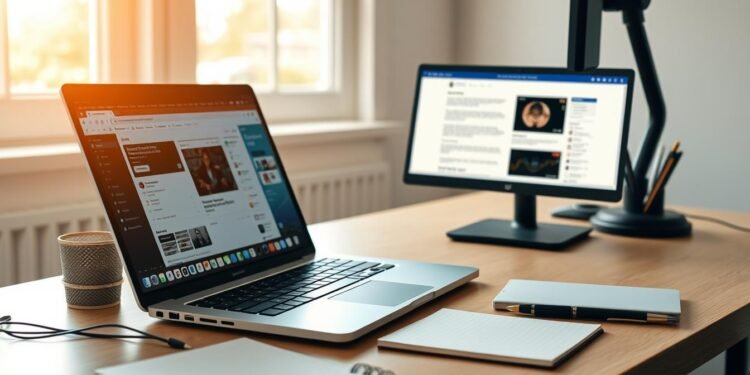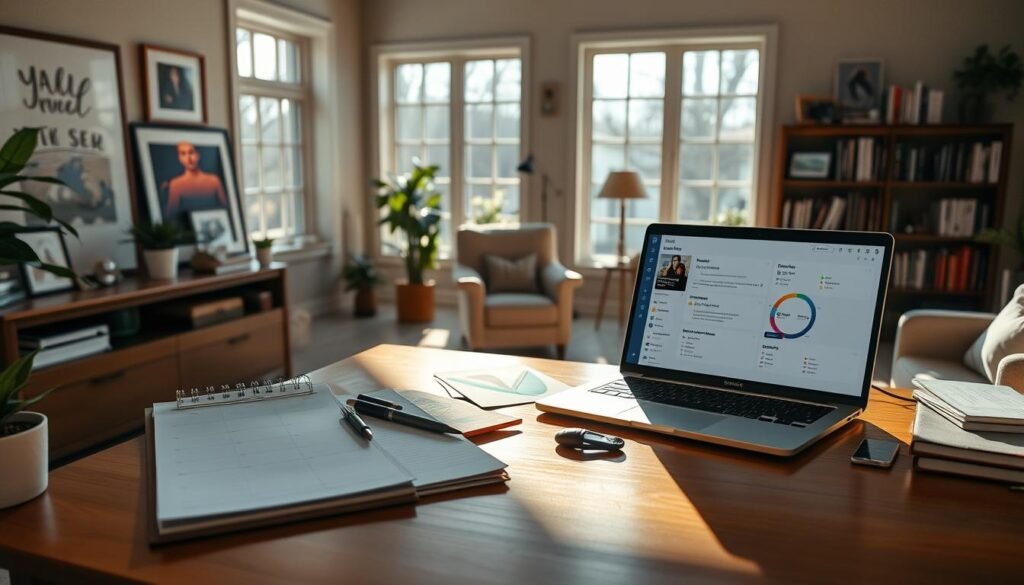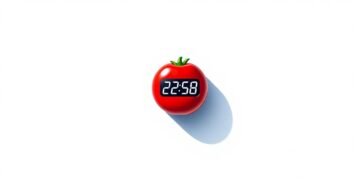Have you ever wondered why, despite working hard, your productivity seems to slip away? Studies show that modern professionals face over 100 daily interruptions, making it nearly impossible to stay focused. These constant distractions often lead to a 40% loss in productivity, leaving us feeling overwhelmed and unaccomplished.
One major culprit? The habit of juggling multiple browser tabs and switching tasks frequently. This fragmented attention not only slows us down but also drains our mental energy. The good news is, there are science-backed strategies to reclaim your focus and boost your efficiency.
In this article, we’ll explore practical solutions like time blocking and workspace optimization. These methods go beyond generic productivity hacks, offering real ways to minimize distractions and maximize your output. Let’s dive in and discover how to work smarter, not harder.
Key Takeaways
- Modern professionals face over 100 daily interruptions, impacting focus.
- Frequent task-switching can lead to a 40% loss in productivity.
- Browser tabs contribute to fragmented attention and mental fatigue.
- Time blocking helps manage tasks more efficiently.
- Workspace optimization minimizes distractions and enhances focus.
- Science-backed strategies offer more effective solutions than generic tips.
Introduction to Tabs & Task-Switching
In today’s fast-paced work environment, staying focused can feel like an uphill battle. We often find ourselves juggling multiple tasks at once, which can lead to a loss of productivity. One of the main challenges is the constant need to switch between different activities, a habit that drains our mental energy.
What is Task-Switching?
Task-switching refers to the rapid shift of attention from one activity to another. Unlike true multitasking, which involves performing multiple tasks simultaneously, task-switching requires a cognitive reset each time you change focus. Research from Stanford shows that this process can reduce efficiency and increase errors.
The Role of Tabs in Modern Workflows
Browser tabs have become a staple in our daily work routines, allowing us to access multiple resources at once. However, they also contribute to the problem of context-switching. When we have too many tabs open, our brain struggles to manage the cognitive load, leading to mental fatigue.
Studies from the University of Sussex highlight that excessive tab usage can impair focus and decision-making. For example, emergency room physicians with more tabs open were found to make more errors. This shows how important it is to manage our digital workspace effectively.
The Impact of Task-Switching on Productivity
Constantly shifting between tasks can feel like running on a treadmill—lots of effort but little progress. This habit not only slows us down but also has a significant impact on our overall productivity. Research shows that frequent changes in focus can lead to a 15-point drop in IQ, similar to the effects of sleep deprivation.
How Task-Switching Affects Your Brain
Our brain isn’t designed to handle rapid shifts in attention. Studies from the University of Sussex reveal that heavy multitaskers experience damage to the anterior cingulate cortex, a region crucial for decision-making and emotional control. This damage can impair our ability to focus and make sound judgments.
Another phenomenon, known as “attention residue,” occurs when part of our mental capacity remains tied to the previous task. This residue reduces our working memory, making it harder to fully engage with the new activity.
The Hidden Costs of Multitasking
While multitasking might seem efficient, it often leads to longer task completion times. A study involving GitHub developers found that task switching increased their work time by 38%. Additionally, reorienting after checking emails alone can cost us up to 1.5 hours daily.
Chronic multitasking doesn’t just harm productivity—it can also lead to increased stress and a decline in emotional intelligence. By understanding these hidden costs, we can take steps to work more effectively and protect our mental well-being.
Why Multitasking is a Myth
Many of us believe multitasking is the key to getting more done, but science tells a different story. While juggling multiple tasks might seem efficient, it often leads to lower productivity and mental fatigue. Research shows that only 2% of people can multitask effectively, making it a rare skill rather than a universal solution.
The Science Behind Multitasking
Studies, like the Utah driving study, reveal that most people struggle with multitasking. fMRI scans show that our brain’s prefrontal cortex becomes overloaded when switching between activities. This overload reduces focus and increases errors, proving that multitasking is more of a hindrance than a help.
Another Buffer study found that self-identified multitaskers experienced a 22% drop in performance. This aligns with Konnikova’s spotlight attention analogy, which compares focus to a printer processing one job at a time. Trying to handle multiple tasks simultaneously only slows us down.
Common Misconceptions About Multitasking
One major myth is the idea of “super-taskers.” Strayer’s research shows that only 2% of people fall into this category. For the rest of us, multitasking damages emotional intelligence and reduces efficiency. Even simple tasks, like walking while talking, can’t compare to complex cognitive activities like working on a spreadsheet.
Understanding these misconceptions helps us rethink our approach to work. By focusing on one task at a time, we can improve both productivity and mental well-being.
Strategies to Reduce Task-Switching
Effective strategies can help us reclaim our time and boost productivity. By minimizing distractions, we can focus better and achieve more in less time. Let’s explore two proven methods: time blocking and task batching.
Time Blocking for Focused Work
Time blocking is a powerful technique to manage your tasks efficiently. It involves scheduling specific blocks of time for each activity, reducing the need to switch tasks frequently. Tools like Akiflow’s drag-and-drop calendar make this process seamless, cutting context switches by 37%.
For interrupted work, try the “mental breadcrumbing” technique. Leave a quick note or bookmark where you left off. This helps you return to the task with minimal reorientation, maintaining your flow.
Task Batching to Minimize Distractions
Task batching groups similar activities together, reducing the cognitive load of shifting focus. A GitHub study found that mono-tasking completes projects 28% faster. Here’s a simple 3-step process for managing emails and Slack:
- Set specific times for checking messages.
- Group related communications into one session.
- Use “catch-up blocks” for high-interruption roles to handle unexpected tasks efficiently.
Google Workspace’s split-screen feature also enhances efficiency. It allows you to view multiple tools side by side, reducing the need to toggle between windows.
By implementing these strategies, we can create a more focused and productive workflow. Small changes in how we manage our tasks can lead to significant improvements in our deep work and overall efficiency.
Tools to Manage Tabs & Tasks Effectively
Finding the right tools to stay organized is essential for maintaining focus. With so many interruptions and scattered workflows, it’s easy to lose track of what matters. Fortunately, there are tools designed to help us manage our tabs and tasks more efficiently.
Let’s explore some of the best solutions available today. These tools not only reduce distractions but also enhance our ability to stay on track and productive.
Best Browser Extensions for Tab Management
OneTab is a standout extension for consolidating tabs. It reduces memory usage by an average of 62%, making it easier to focus on what’s important. Another great option is Framer, which uses a breadcrumb system to cut navigation errors by 33%.
For those who struggle with too many open windows, these extensions can be a game-changer. They help streamline your workflow and keep your digital workspace clutter-free.
Task Management Apps to Stay Organized
Akiflow is a powerful app that uses priority tagging to organize tasks into Level 2, 3, and 4 categories. This system ensures that you tackle the most important work first. Granola, on the other hand, reduces meeting follow-ups by 41% through automated notes.
If you’re looking for website-blocking solutions, compare Forest and Freedom. Forest gamifies focus, while Freedom blocks distracting sites entirely. Both are excellent for minimizing interruptions.
For visual task batching, ClickUp and Trello are top choices. They allow you to organize tasks visually, making it easier to manage complex projects. Zoom’s detachable panels also offer workspace customization, enhancing efficiency.
By leveraging these tools, we can create a more focused and productive workflow. Small changes in how we manage our tasks can lead to significant improvements in our focus and overall efficiency.
Designing Your Workspace for Better Focus
Your workspace setup plays a bigger role in focus than you might think. Whether it’s your digital or physical environment, small changes can make a huge difference. Studies show that physicians using clean interfaces respond 19% faster, proving that organization matters.
How to Arrange Your Digital Workspace
Start by organizing your desktop into three layers: active, reference, and archive. This system helps you prioritize resources and reduces clutter. For example, keep only the files you’re actively using on your desktop.
Consider a dual monitor setup with vertical orientation. This arrangement minimizes distractions and improves workflow efficiency. Tools like Google Drive’s background upload feature also save time by handling file transfers seamlessly.
MacOS Focus Mode is another great option. It reduces notification-driven switches by 54%, helping you stay in the zone. These small tweaks can transform your digital workspace into a productivity powerhouse.
Physical Workspace Tips for Reduced Distractions
Your physical environment is just as important. Begin with a 5-step desk decluttering protocol. Remove unnecessary items and keep only what you need within arm’s reach. This creates a clean and focused context for work.
Lighting also plays a key role. Use the “peripheral vision” technique from UX research. Soft, indirect lighting reduces eye strain and keeps you alert. Pair this with an ergonomic chair and desk setup for maximum comfort.
Finally, keep your workspace free from visual clutter. A tidy desk not only boosts focus but also reduces stress. By optimizing both your digital and physical spaces, you can create an environment that supports deep work and minimizes distractions.
Maintaining Focus in a Distracted World
In a world full of distractions, staying focused can feel like a constant battle. Our attention is pulled in countless directions, making it harder to achieve meaningful work. But with the right strategies, we can reclaim our focus and reduce the stress that comes with constant interruptions.
Techniques to Improve Concentration
One effective method is the Pomodoro 2.0 technique. Unlike the traditional version, this approach uses variable interval lengths to match your natural rhythm. For example, work for 25 minutes, then take a 5-minute break. This keeps your mind engaged without overwhelming it.
Another strategy is the “single tab” challenge from Ethicontrol. Commit to using only one browser tab at a time. This reduces cognitive overload and helps you stay focused on the task at hand. Small changes like these can make a big difference in your productivity.
How to Handle Interruptions Gracefully
Interruptions are inevitable, but how we handle them matters. Create an “interruption bouncer” phrasebook for colleagues. Phrases like “Can we discuss this in 10 minutes?” or “Let’s schedule a time to talk” help set boundaries without causing friction.
Tools like Otter.ai can also help. Its real-time transcription feature allows you to focus during meetings instead of scrambling to take notes. Additionally, 15-minute buffer zones between tasks reduce cognitive strain by 28%, giving your mind time to reset.
By implementing these techniques, we can navigate distractions more effectively and protect our attention. Focus is a skill, and with practice, it becomes a powerful part of our daily lives.
Conclusion
Mastering focus in a distracted world requires intentional effort and smart strategies. By focusing on three core principles—intentionality, tool mastery, and workspace design—we can significantly improve our productivity and reduce distractions.
We invite you to take our 30-day focus challenge. This program includes measurable benchmarks to track your progress and help you stay on course. Tools like Akiflow have been shown to reduce tab overload by 37%, making it easier to maintain focus during work.
Beware of the “multitasking pride” cognitive trap. While it may feel efficient, multitasking often leads to lower quality work and increased stress. Instead, focus on one task at a time to achieve better results.
For those ready to take the next step, we offer a focus audit template and a tool comparison chart. These resources will help you create a more organized and efficient workflow. Let’s work smarter, not harder, and reclaim our time and focus.
FAQ
What is task-switching?
Task-switching is the act of moving between different activities or projects. It often feels like multitasking, but it can reduce focus and increase errors.
How does task-switching affect productivity?
Switching tasks frequently can slow you down and lower the quality of your work. It forces your brain to reset, which takes time and mental energy.
Is multitasking really effective?
No, multitasking is a myth. Research shows it splits your attention, making it harder to complete tasks efficiently or accurately.
What are some strategies to reduce task-switching?
Try time blocking to focus on one task at a time or batch similar tasks together. These methods help minimize distractions and improve efficiency.
Are there tools to manage tabs and tasks better?
Yes, tools like browser extensions for tab management and task management apps can help you stay organized and reduce unnecessary switching.
How can I design my workspace for better focus?
Arrange your digital workspace by closing unused tabs and organizing files. For your physical space, reduce clutter and limit distractions like noise.
What techniques can improve concentration?
Techniques like deep work, mindfulness, and setting clear priorities can help you stay focused and handle interruptions more effectively.








